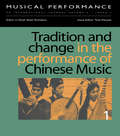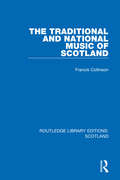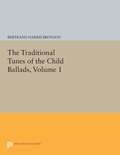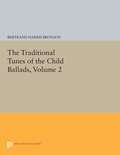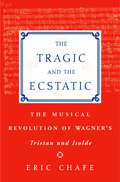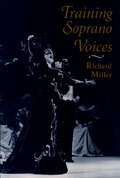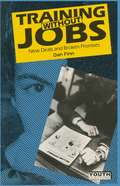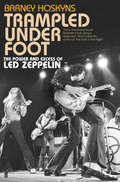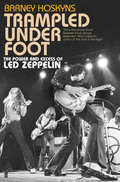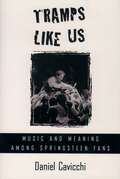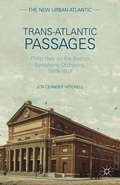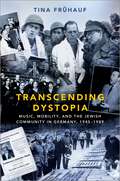- Table View
- List View
Tradition & Change Performance (Musical Performance Ser. #Vols. 2, Pts. 2.)
by TsaoFirst published in 1998. Routledge is an imprint of Taylor & Francis, an informa company.
Tradition & Change Performance
by TsaoFirst published in 1998. Routledge is an imprint of Taylor & Francis, an informa company.
Tradition, Community, and Nationhood in Richard Wagner’s Die Meistersinger von Nürnberg (Rethinking Austrian and German Music)
by Christopher KimbellSince its premiere in 1868, Wagner’s Die Meistersinger von Nürnberg has defied repeated upheavals in the cultural-political landscape of German statehood to retain its unofficial status as the German national opera. The work’s significance as a touchstone of national culture survived even such troubling episodes as its public endorsement in 1933 as ‘the most German of all German operas’ by Joseph Goebbels or the rendition in previous years by audiences at Bayreuth of both national and Nazi-party anthems at the work’s culmination. This chequered reception history and apparent propensity for reinterpretation or reclamation has long fuelled debates over the socio-political meanings of Wagner’s musical narrative. On the question of Beckmesser, for instance, heated arguments have surrounded the existence of antisemitic stereotypes in the work as well as their possible indication of a racial-political dimension to Sachs’s restoration of Nuremberg society. Through a combination of musical-textual analysis with critical theory, this book interrogates the ideological underpinnings of Die Meistersinger’s narrative. In four interconnected studies of the characters of Walther, Sachs, Beckmesser, and Eva, the book traces a critical potential within the opera’s construction of provincial and national identities and problematizes existing discourse around its depiction of race and gender.
Tradition, Community, and Nationhood in Richard Wagner’s Die Meistersinger von Nürnberg (Rethinking Austrian and German Music)
by Christopher KimbellSince its premiere in 1868, Wagner’s Die Meistersinger von Nürnberg has defied repeated upheavals in the cultural-political landscape of German statehood to retain its unofficial status as the German national opera. The work’s significance as a touchstone of national culture survived even such troubling episodes as its public endorsement in 1933 as ‘the most German of all German operas’ by Joseph Goebbels or the rendition in previous years by audiences at Bayreuth of both national and Nazi-party anthems at the work’s culmination. This chequered reception history and apparent propensity for reinterpretation or reclamation has long fuelled debates over the socio-political meanings of Wagner’s musical narrative. On the question of Beckmesser, for instance, heated arguments have surrounded the existence of antisemitic stereotypes in the work as well as their possible indication of a racial-political dimension to Sachs’s restoration of Nuremberg society. Through a combination of musical-textual analysis with critical theory, this book interrogates the ideological underpinnings of Die Meistersinger’s narrative. In four interconnected studies of the characters of Walther, Sachs, Beckmesser, and Eva, the book traces a critical potential within the opera’s construction of provincial and national identities and problematizes existing discourse around its depiction of race and gender.
The Traditional and National Music of Scotland (Routledge Library Editions: Scotland #10)
by Francis CollinsonOriginally published in 1966, this was the first book on this subject to be published for over a hundred years. It covers all facets including little-known types of Gaelic song, the bagpipes and their music, including the esoteric subject of pibroch, the Ceol Mor or ‘Great Music’ of the pipes. It gives a comprehensive review of the fiddle composers and their music, and of the Clarsach and its revival, with an example of all-but-extinct Scottish harp music. A chapter is devoted to the music of Orkney and Shetland and the book contains over 100 examples of music many of which were from the author’s own collection and published here for the first time.
The Traditional and National Music of Scotland (Routledge Library Editions: Scotland #10)
by Francis CollinsonOriginally published in 1966, this was the first book on this subject to be published for over a hundred years. It covers all facets including little-known types of Gaelic song, the bagpipes and their music, including the esoteric subject of pibroch, the Ceol Mor or ‘Great Music’ of the pipes. It gives a comprehensive review of the fiddle composers and their music, and of the Clarsach and its revival, with an example of all-but-extinct Scottish harp music. A chapter is devoted to the music of Orkney and Shetland and the book contains over 100 examples of music many of which were from the author’s own collection and published here for the first time.
Traditional Music and Irish Society: Historical Perspectives (Ashgate Popular and Folk Music Series)
by Martin DowlingWritten from the perspective of a scholar and performer, Traditional Music and Irish Society investigates the relation of traditional music to Irish modernity. The opening chapter integrates a thorough survey of the early sources of Irish music with recent work on Irish social history in the eighteenth century to explore the question of the antiquity of the tradition and the class locations of its origins. Dowling argues in the second chapter that the formation of what is today called Irish traditional music occurred alongside the economic and political modernization of European society in the late eighteenth and early nineteenth centuries. Dowling goes on to illustrate the public discourse on music during the Irish revival in newspapers and journals from the 1880s to the First World War, also drawing on the works of Pierre Bourdieu and Jacques Lacan to place the field of music within the public sphere of nationalist politics and cultural revival in these decades. The situation of music and song in the Irish literary revival is then reflected and interpreted in the life and work of James Joyce, and Dowling includes treatment of Joyce’s short stories A Mother and The Dead and the 'Sirens' chapter of Ulysses. Dowling conducted field work with Northern Irish musicians during 2004 and 2005, and also reflects directly on his own experience performing and working with musicians and arts organizations in order to conclude with an assessment of the current state of traditional music and cultural negotiation in Northern Ireland in the second decade of the twenty-first century.
Traditional Music and Irish Society: Historical Perspectives (Ashgate Popular and Folk Music Series)
by Martin DowlingWritten from the perspective of a scholar and performer, Traditional Music and Irish Society investigates the relation of traditional music to Irish modernity. The opening chapter integrates a thorough survey of the early sources of Irish music with recent work on Irish social history in the eighteenth century to explore the question of the antiquity of the tradition and the class locations of its origins. Dowling argues in the second chapter that the formation of what is today called Irish traditional music occurred alongside the economic and political modernization of European society in the late eighteenth and early nineteenth centuries. Dowling goes on to illustrate the public discourse on music during the Irish revival in newspapers and journals from the 1880s to the First World War, also drawing on the works of Pierre Bourdieu and Jacques Lacan to place the field of music within the public sphere of nationalist politics and cultural revival in these decades. The situation of music and song in the Irish literary revival is then reflected and interpreted in the life and work of James Joyce, and Dowling includes treatment of Joyce’s short stories A Mother and The Dead and the 'Sirens' chapter of Ulysses. Dowling conducted field work with Northern Irish musicians during 2004 and 2005, and also reflects directly on his own experience performing and working with musicians and arts organizations in order to conclude with an assessment of the current state of traditional music and cultural negotiation in Northern Ireland in the second decade of the twenty-first century.
Traditional Musics in the Modern World: Transmission, Evolution, and Challenges (Landscapes: the Arts, Aesthetics, and Education #24)
by Bo-Wah LeungThis book reviews the current practices of traditional musics in various cultures of all continents, and examines the impact and significance of traditional musics in the modern world. A diverse group of experts of musicology and music education collaborate to expose the current practices and challenges of transmission and evolution of traditional musics in order to seek sustainable development, so that traditional musics can take the place they deserve in the modern world and continue to contribute to human civilization. This volume contains three main sections that include transmission of traditional musics, authenticity and evolution, as well as challenges in future. Based on the chapters, the editor proposes four major trends of transmission of traditional musics, namely, formalization, politicization, Westernization and modernization in transforming contexts.
The Traditional Tunes of the Child Ballads, Volume 1
by Bertrand Harris BronsonThis is the musical counterpart to the famous Francis James Child collection of English and Scottish ballads from the 13th to the 19th centuries. Professor Child's canon established the texts; Professor Bronson’s work provides both tunes and texts.Originally published in 1959.The Princeton Legacy Library uses the latest print-on-demand technology to again make available previously out-of-print books from the distinguished backlist of Princeton University Press. These editions preserve the original texts of these important books while presenting them in durable paperback and hardcover editions. The goal of the Princeton Legacy Library is to vastly increase access to the rich scholarly heritage found in the thousands of books published by Princeton University Press since its founding in 1905.
The Traditional Tunes of the Child Ballads, Volume 2
by Bertrand Harris BronsonContinuing the monumental work begun in Volume I, Bertrand Bronson presents here the words and music for Child Ballads 54 through 113. The texts are those established in the famous Child canon of English and Scottish ballads. To them, Mr. Bronson has added more than a thousand variant tunes grouped to show their melodic kinship, and the characteristic variations developed in the course of traditional singing and oral transmission.Originally published in 1962.The Princeton Legacy Library uses the latest print-on-demand technology to again make available previously out-of-print books from the distinguished backlist of Princeton University Press. These editions preserve the original texts of these important books while presenting them in durable paperback and hardcover editions. The goal of the Princeton Legacy Library is to vastly increase access to the rich scholarly heritage found in the thousands of books published by Princeton University Press since its founding in 1905.
The Traditional Tunes of the Child Ballads, Volume 4: With Their Texts, according to the Extant Records of Great Britain and America
by Bertrand Harris BronsonWith this volume, incorporating Ballads 244-305, Bertrand Harris Bronson completes his epic task of providing the musical counterpart to Francis James Child's collection of English and Scottish ballads. As in the previous volumes, the texts are linked with their proper traditional tunes, systematically ordered and grouped to show melodic kinship and characteristic variations developed during the course of oral transmission.Originally published in 1972.The Princeton Legacy Library uses the latest print-on-demand technology to again make available previously out-of-print books from the distinguished backlist of Princeton University Press. These editions preserve the original texts of these important books while presenting them in durable paperback and hardcover editions. The goal of the Princeton Legacy Library is to vastly increase access to the rich scholarly heritage found in the thousands of books published by Princeton University Press since its founding in 1905.
Traditions, Institutions, and American Popular Tradition: A special issue of the journal Contemporary Music Review
by John Covach Walter EverettFirst Published in 2000. Routledge is an imprint of Taylor & Francis, an informa company.
Traditions, Institutions, and American Popular Tradition: A special issue of the journal Contemporary Music Review
by Peter Nelson Nigel OsborneFirst Published in 2000. Routledge is an imprint of Taylor & Francis, an informa company.
The Tragic and the Ecstatic: The Musical Revolution of Wagner's Tristan and Isolde
by ChafeDuring the years preceding the composition of Tristan and Isolde, Wagner's aesthetics underwent a momentous turnaround, principally as a result of his discovery of Schopenhauer. Many of Schopenhauer's ideas, especially those regarding music's metaphysical significance, resonated with patterns of thought that had long been central to Wagner's aesthetics, and Wagner described the entry of Schopenhauer into his life as "a gift from heaven." Chafe argues that Wagner's Tristan and Isolde is a musical and dramatic exposition of metaphysical ideas inspired by Schopenhauer. The first part of the book covers the philosophical and literary underpinnings of the story, exploring Schopenhauer's metaphysics and Gottfried van Strassburg's Tristan poem. Chafe then turns to the events in the opera, providing tonal and harmonic analyses that reinforce his interpretation of the drama. Chafe acts as an expert guide, interpreting and illustrating most important moments for his reader. Ultimately, Chafe creates a critical account of Tristan, in which the drama is shown to develop through the music.
The Tragic and the Ecstatic: The Musical Revolution of Wagner's Tristan and Isolde
by ChafeDuring the years preceding the composition of Tristan and Isolde, Wagner's aesthetics underwent a momentous turnaround, principally as a result of his discovery of Schopenhauer. Many of Schopenhauer's ideas, especially those regarding music's metaphysical significance, resonated with patterns of thought that had long been central to Wagner's aesthetics, and Wagner described the entry of Schopenhauer into his life as "a gift from heaven." Chafe argues that Wagner's Tristan and Isolde is a musical and dramatic exposition of metaphysical ideas inspired by Schopenhauer. The first part of the book covers the philosophical and literary underpinnings of the story, exploring Schopenhauer's metaphysics and Gottfried van Strassburg's Tristan poem. Chafe then turns to the events in the opera, providing tonal and harmonic analyses that reinforce his interpretation of the drama. Chafe acts as an expert guide, interpreting and illustrating most important moments for his reader. Ultimately, Chafe creates a critical account of Tristan, in which the drama is shown to develop through the music.
The Train in the Night: A Story of Music and Loss
by Nick ColemanSHORTLISTED FOR THE 2012 WELLCOME TRUST BOOK PRIZEHow do you lose music? Then having lost it, what do you do next? Nick Coleman found out the morning he woke up to a world changed forever by Sudden Neursosensory Hearing Loss. The Train in the Night is an account of one man's struggle to recover from the loss of his greatest passion - and go one further than that: to restore his ability not only to hear but to think about and feel music, by going back to the series of big bangs which kicked off his musical universe.The result a memoir not quite like any other. It is about growing up, about taste and love and suffering and delusion and longing to be Keith Richards. It is funny, heartbreaking and, above all, true.
Training Soprano Voices
by Richard MillerTraining Soprano Voices provides a complete and reliable system for training each type of soprano voice. Designed as a practical program for singers, teachers, and voice professionals, it couples historic vocal pedagogy with the latest research on the singing voice, emphasizing the special nature of the soprano voice and the proper physiological functioning for vocal proficiency. Renowned singing teacher Richard Miller supplies a detailed description for each of the nine categories of soprano voices. For each category he then surveys the appropriate literature and provides an effective system for voice building, including techniques for breath management, vibratory response, resonance balancing, language articulation, vocal agility, sostenuto, proper vocal registration, and dynamic control. The book concludes with a daily regimen of vocal development for healthy singing and artistic performance. It also features dozens of technical exercises, vocalization material taken from the performance literature, and numerous anatomical illustrations. Unique in its focus on a single voice, Training Soprano Voices is likely to set the standard in voice training for years to come.
Training Soprano Voices
by Richard MillerTraining Soprano Voices provides a complete and reliable system for training each type of soprano voice. Designed as a practical program for singers, teachers, and voice professionals, it couples historic vocal pedagogy with the latest research on the singing voice, emphasizing the special nature of the soprano voice and the proper physiological functioning for vocal proficiency. Renowned singing teacher Richard Miller supplies a detailed description for each of the nine categories of soprano voices. For each category he then surveys the appropriate literature and provides an effective system for voice building, including techniques for breath management, vibratory response, resonance balancing, language articulation, vocal agility, sostenuto, proper vocal registration, and dynamic control. The book concludes with a daily regimen of vocal development for healthy singing and artistic performance. It also features dozens of technical exercises, vocalization material taken from the performance literature, and numerous anatomical illustrations. Unique in its focus on a single voice, Training Soprano Voices is likely to set the standard in voice training for years to come.
Training without Jobs: New Deals and Broken Promises (Youth Questions)
by D. FinnFor more than a century the state has prohibited children from obtaining full time employment and it has assumed increasing control over the conditions awaiting school leavers in the labour market. This book traces these developments from the introduction of compulsory schooling to the creating of the two year Youth Training Scheme. It draws on a wealth of empirical studies of young people at school and at work both to illustrate how raising the school leaving age to 16 failed to deliver what it promised, and to reveal how the Conservative government elected in 1979 redefined the relationship between education, training and work. Through a detailed critique of the development and politics of the Manpower Services Commission, the book shows how the power of the state has been used to manage and contain the political crisis of mass unemployment. It also reveals, however, that young people are unlikely to accept meekly the new social and economic status that the government has created for them. Many have little confidence in the cynical offers of Training Without Jobs.
Trampled Under Foot: The Power and Excess of Led Zeppelin
by Barney HoskynsThis edition contains over two and a half hours of audio interviews with members of Led Zeppelin.A unique look at the history, adventures, myths and realities of this most legendary and powerful of bands, Trampled Under Foot is a labour of love based on hours of first-hand and original interviews. What emerges is a compelling portrait of the four musicians themselves, as well as a fresh insight into the close-knit entourage that protected them, from Peter Grant to Richard Cole to Ahmet Ertegun, giant figures from the long-vanished world of 1970s rock.Featuring many rare and never before seen photographs, it is also the first book on Led Zeppelin to cover such recent events as their triumphant 2007 O2 Arena gig and Robert Plant's Grammy-winning resurgence of recent years.
Trampled Under Foot: The Power and Excess of Led Zeppelin
by Barney HoskynsA unique look at the history, adventures, myths and realities of this most legendary and powerful of bands, it is a labour of love based on hours of first-hand and original interviews. What emerges is a compelling portrait of the four musicians themselves, as well as a fresh insight into the close-knit entourage that protected them, from Peter Grant to Richard Cole to Ahmet Ertegun, giant figures from the long-vanished world of 1970s rock.Featuring many rare and never before seen photographs, it is also the first book on Led Zeppelin to cover such recent events as their triumphant 2007 O2 Arena gig and Robert Plant's Grammy-winning resurgence of recent years.
Tramps Like Us: Music and Meaning among Springsteen Fans
by Daniel CavicchiAs rock critics have noted in the past, Bruce Springsteen's songs exist in a world of their own--they have their own settings, characters, words, and images. It is a world that even those who know only a handful of Springsteen's lyrics can instantly recognize, a world of highways and factories, loners and underdogs, hot rods and patrol cars. And it is a world that stretches far beyond the New Jersey state line. Indeed, Springsteen's attention to the ideals and struggles of ordinary Americans has significantly influenced American popular culture and public debate. As a rock-and-roll troubadour, "the Boss" speaks not only for his many fans but to them, and often with a directness or sincerity that no other performer can match. But what can be said of the fans themselves? Why and how do they relate to Springsteen's words and music? Based on three years of ethnographic research amid Springsteen's fans, and informed by the author's own experiences and impressions as a fan, Daniel Cavicchi's Tramps Like Us is an interdisciplinary study of the ways in which ordinary people form special, sustained attachments to a particular singer/songwriter and his songs, and of how these attachments function in people's lives. An "insider's narrative" about Springsteen fans--who they are, what they do, and why they do it--this book also investigates the phenomenon of fandom in general. The text oscillates between fans' stories and ideas and Cavicchi's own anecdotes, commentary, and analysis. It challenges the stereotypes of fans as obsessive, delusional, and even mentally ill, and explores fandom as a normal socio-cultural activity. Ultimately, this book argues that music fandom is a useful and meaningful behavior that enables us to shape identities, create communities, and make sense of the world--both Bruce's and our own.
Trans-Atlantic Passages: Philip Hale on the Boston Symphony Orchestra, 1889-1933 (The New Urban Atlantic)
by J. MitchellPhilip Hale (1854-1934) helped put Boston on the Transatlantic map through his music writing. Mitchell reconstructs Hale's oeuvre to produce an authoritative account of the role the Boston Symphony played in the international world of nineteenth- and early twentieth-century music.
Transcending Dystopia: Music, Mobility, and the Jewish Community in Germany, 1945-1989
by Tina FrühaufBy the end of the Second World War, Germany was in ruins and its Jewish population so gravely diminished that a rich cultural life seemed unthinkable. And yet, as surviving Jews returned from hiding, the camps, and their exiles abroad, so did their music. Transcending Dystopia tells the story of the remarkable revival of Jewish musical activity that developed in postwar Germany against all odds. Author Tina Frühauf provides a kaleidoscopic panorama of musical practices in worship and social life across the country to illuminate how music contributed to transitions and transformations within and beyond Jewish communities in the aftermath of the Holocaust. Drawing on newly unearthed sources from archives and private collections, this book covers a wide spectrum of musical activity-from its role in commemorations and community events to synagogue concerts and its presence on the radio-across the divided Germany until the Fall of the Wall in 1989. Frühauf's use of mobility as a conceptual framework reveals the myriad ways in which the reemergence of Jewish music in Germany was shaped by cultural transfer and exchange that often relied on the circulation of musicians, their ideas, and practices within and between communities. By illuminating the centrality of mobility to Jewish experiences and highlighting how postwar Jewish musical practices in Germany were defined by politics that reached across national borders to the United States and Israel, this pioneering study makes a major contribution to our understanding of Jewish life and culture in a transnational context.
